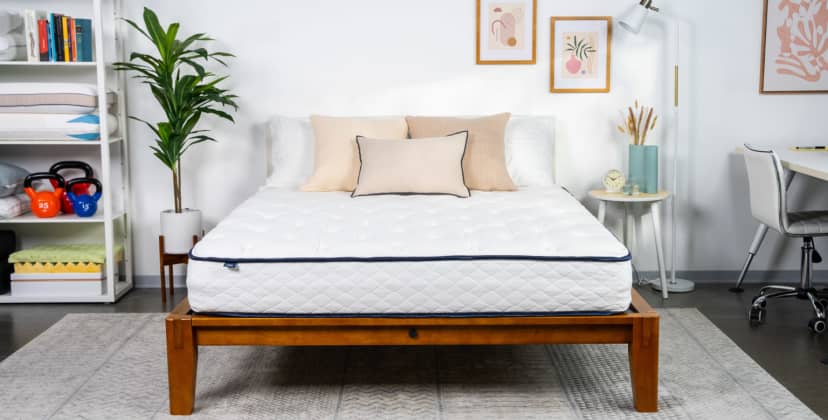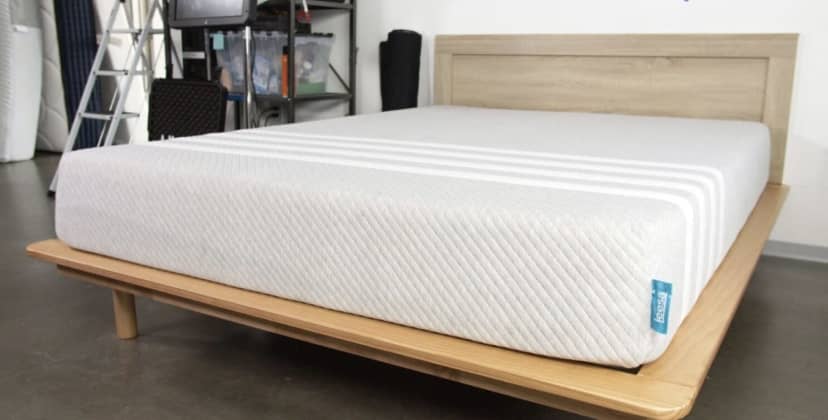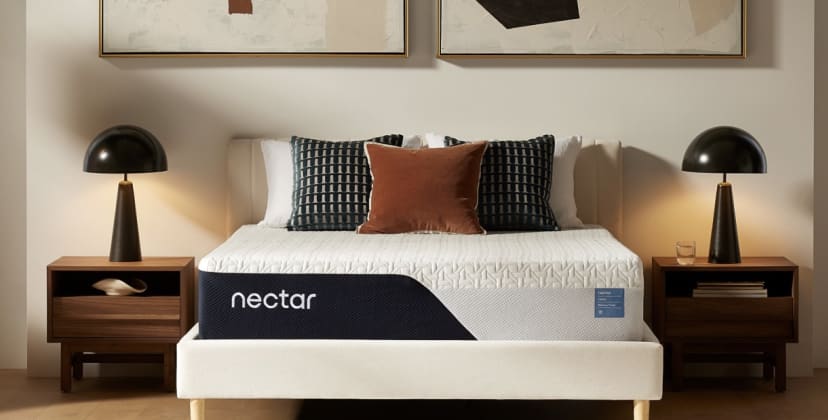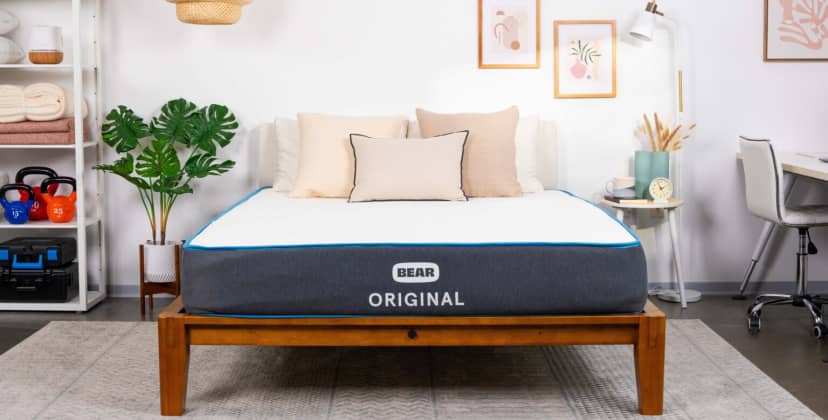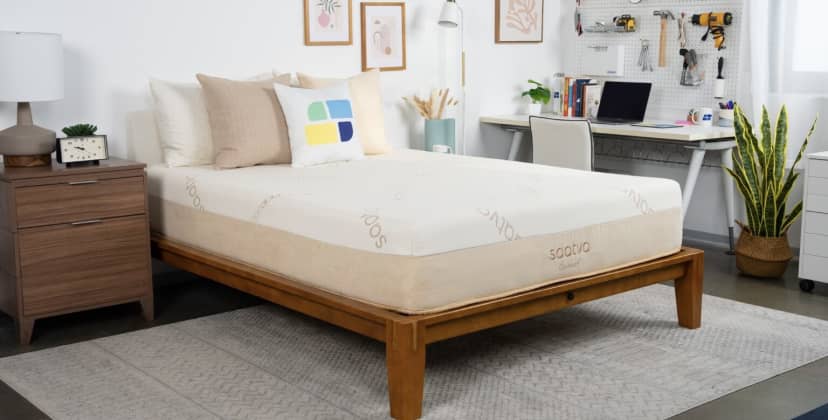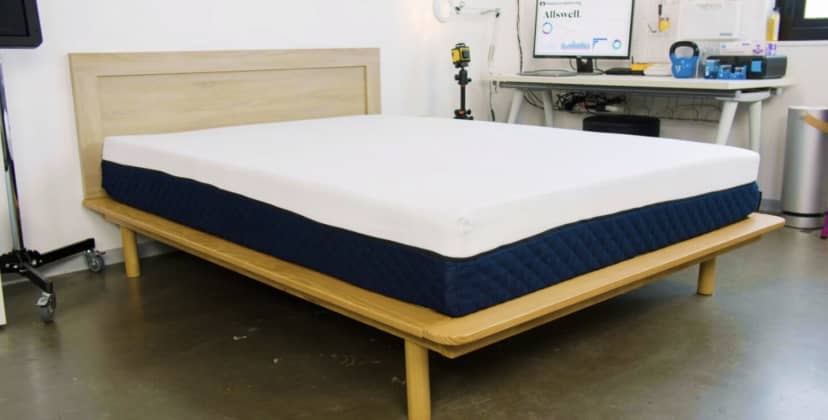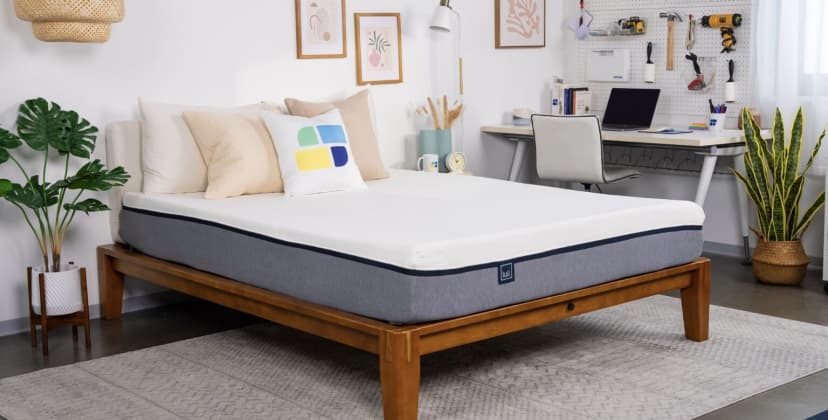When you buy through our links, we may earn a commission. Products or services may be offered by an affiliated entity. Learn more.
Best Memory Foam Mattress
As it turns out, memory foam had a pretty cool first gig: It was created by a NASA contractor to cushion and protect pilots during test flights . Back on Earth, it quickly became a favorite for mattresses thanks to its ability to conform to the body, relieve pressure, and absorb motion like a pro.
As someone who’s slept on all kinds of different mattresses, I can tell you that memory foam has a very specific feel. No other material hugs the body in the same way. And there’s a lot of variation in foam beds. But after nearly a decade of testing over 600 foam mattresses, I’ve learned a lot about what makes a good memory foam bed — and who they’re best for. Below, I’ll share what to look for, as well as our team’s top picks based on hands-on testing.
Our Top Picks
- Best Overall Mattress – WinkBeds GravityLux
- Most Comfortable Mattress – Leesa Original
- Best Value Mattress – Nectar Classic
- Best Mattress for Side Sleepers – Nolah Signature 12
- Best Mattress for Back Pain – Bear Original
- Best Luxury Mattress – Saatva Contour5
- Best Mattress for Hot Sleepers – Silk & Snow Mattress
- Best Mattress for Combo Sleepers – Layla Memory Foam
- Best Mattress for Couples – Lull Original Mattress
In-Depth Reviews
Our entire team agrees: The GravityLux is a top-notch memory foam mattress. It strikes a nice balance between pressure relief, responsiveness, and cooling. Even the softest model feels supportive, which isn’t always the case with plush foam beds. With multiple firmness options, it’s a great pick whether you’re sharing the bed with a partner or sleeping solo, and it works well for a variety of body types and sleep positions.
-
Pros
-
Foam comfort system provides exceptional pressure relief and motion isolation
-
Breathable Tencel cover and open-cell foam keeps the mattress cool
-
Choice of three firmness levels
-
-
Cons
-
Limited edge support for most models
-
Off-gassing odor may be overpowering at first
-
Mattress Type
Foam
Firmness Options
Medium Soft (4), Medium (5), Firm (7)
Price Range
$899 – $1,699
Trial Period
120 nights (30 night requirement)
Who It’s Best For
A truly versatile option with three firmness levels, sleepers across weight ranges who sleep on their side, back, or stomach can find a model that works well for them. People with back pain rave about this mattress’s pressure relief capabilities.
Feel
Compared to other all-foam mattresses, the WinkBed GravityLux feels luxurious. It’s plush and cradles your body well but not too well, comfortable yet supportive enough to relieve pressure, stays cool, and isolates motion well.
What It’s Made Of
The mattress has a breathable Tencel cover, polyfoam layers, AirCell memory foam, a transition layer, and a high-density polyfoam support core.
What We Don’t Like
As a memory-foam model, it does emit strong off-gassing odors upon unboxing. Its edge support could be stronger, and the price point is in line with other premium options but starts high.
Trial, Shipping, and Warranty
WinkBeds offers a 120-night sleep trial, a lifetime warranty, and free shipping within the contiguous U.S.
The Leesa Original is a great option if you’re looking for deep cushioning and solid pressure relief. It has a true medium (5) feel that works well for a variety of sleepers, and in my experience, it really holds up over time without losing its shape or support.
-
Pros
-
Thick foam comfort system closely contours to the body to relieve pressure buildup
-
All-foam construction absorbs motion transfer
-
Excellent cushioning for most side sleepers
-
-
Cons
-
May not provide sufficient support for stomach sleepers
-
High off-gassing potential due to all-foam construction
-
Mattress Type
Foam
Firmness Options
Medium (5)
Price Range
$699 – $1,299
Trial Period
100 nights (30 night requirement)
Who It’s Best For
The Original is an an excellent choice for side sleepers who weigh up to 230 pounds and back-sleepers weighing 130 pounds or less. Those looking for pressure relief will find it in its memory foam comfort layer and support core.
Feel
The 10-inch Leesa Original is soft yet supportive and its thick comfort system appeals to people who prioritize cushioning in high pressure areas like hips and shoulders.
What It’s Made Of
The Original’s four-layer construction starts with a memory foam top and soft polyfoam layer followed by contouring memory foam that relieves joint pressure. The core is made of high-density polyfoam core for spinal-alignment support, and it also minimizes sagging.
What We Don’t Like
It might not be supportive enough for heavier individuals, and its firmer feel may not suit all sleep preferences. Additionally, some users noted initial off-gassing odors and minimal edge support.
Trial, Shipping, and Warranty
Purchases come with a 100-night sleep trial, where you can return the mattress after a 30-night break-in period. Leesa backs the mattress with a 10-year warranty.
I’ve tested a lot of mattresses at this price point, and the Nectar stands out for its pressure relief and motion isolation. I also appreciate that it comes with a full year-long sleep trial — it takes the pressure off when you’re trying to find the right fit.
-
Pros
-
Absorbs motion well, making it ideal for couples
-
Comfortable for side, back, and stomach sleepers up to 230 pounds
-
Solid value and backed by a 365-day sleep trial and warranty
-
-
Cons
-
May be too soft for sleepers over 230 pounds
-
May trap too much heat for those who sleep hot
-
Mattress Type
Foam
Firmness Options
Medium Firm (6)
Price Range
$349 – $1,098
Trial Period
365 nights (30-night requirement)
Who It’s Best For
The Nectar’s moderate contouring and cushioning is a great match for side and back sleepers weighing up to 230 pounds. Superior motion isolation also makes the mattress suitable for couples, while the cushy top layer is a major selling point for people living with chronic or frequent pain.
Feel
The Nectar is medium firm (6). Although the topmost layer is plush and adaptive, the underlying transitional and base foams provide good overall stability — this means most people won’t sink too much into the mattress.
What It’s Made Of
The Nectar’s top layer consists of memory foam infused with cooling gel, which is intended to reduce heat buildup. Dense foam makes up the transitional and support layers, and the cover is composed of a breathable polyester-nylon blend.
What We Don’t Like
Heat buildup may occur despite the top layer’s cooling gel. You’ll also notice strong off-gassing for the first few nights — we recommend airing out the mattress in a well-ventilated room until the smells completely dissipate.
Trial, Shipping, and Warranty
In addition to the affordable pricing, Nectar further incentivizes value seekers with free shipping anywhere in the contiguous U.S. and a sleep trial that spans 365 nights in length. The mattress is backed by a lifetime warranty covering structural and manufacturing defects for as long as you retain full ownership.
Best for Side Sleepers
Nolah Signature 12
25% off sitewide. Save an additional $50 with code: SF50
Shop Now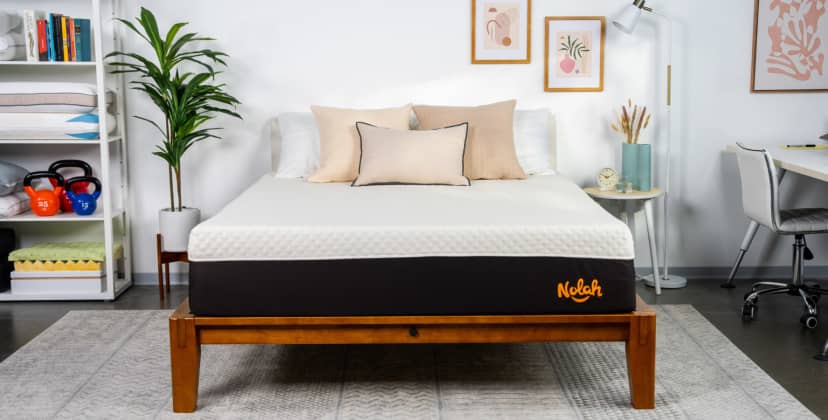
The Nolah Signature 12 has been one of the best all-foam mattresses I’ve tested for side sleepers — especially if you’re on the lighter side. It hits that sweet spot between plush pressure relief and reliable support, and it stays cool throughout the night without that heat-trapping feel some foams can have.
-
Pros
-
Proprietary AirFoam intended to cushion the body without trapping heat
-
Foam layers provide very good motion isolation and pressure relief
-
Buyers can save money by opting out of the sleep trial
-
-
Cons
-
Most back and stomach sleepers experience uncomfortable sinkage
-
Limited perimeter support can make the edges feel unstable
-
Mattress Type
Foam
Firmness Options
Medium (5)
Price Range
$844 – $1,819
Trial Period
120 nights (30-night requirement, $99 return shipping)
Who It’s Best For
The Nolah Signature 12 works best for side-sleepers weighing up to 230 pounds but also adequately supports back and stomach sleepers under 130 pounds. It’s also good for hot sleepers and people drawn to a lifetime warranty.
Feel
The presence of adaptive “AirFoam” polyfoam instead of memory foam prevents sinkage and curbs heat retention. Its medium feel (5/10) balances cushioning and support and provides top-notch pressure relief in the shoulders and hips.
What It’s Made Of
The five layer Signature 12 comes with a cooling AirFoam top layer, high-resilience polyfoam, a denser AirFoam layer for support, a high-density polyfoam core, and a cover made of organic cotton.
What We Don’t Like
Back, stomach, and heavier sleepers over 230 pounds might experience some sinkage. The edges might feel a bit unstable due to limited perimeter support. The base price is also higher than similar all-foam mattresses.
Trial, Shipping, and Warranty
All customers in the contiguous U.S. qualify for free ground shipping with their Signature 12 order. Nolah offers a 120-night sleep trial, but you may opt out of the return period and save some money on your purchase. The mattress is also backed by a lifetime manufacturer’s warranty.
The Bear Original stands out as one of the best values I’ve found in an all-foam mattress. It’s supportive enough to keep my back happy, but still comfortable — plus, the cooling features really help if you’re worried about heat retention.
-
Pros
-
Graphite and gel-infused foams designed to keep you cool
-
All-foam design with a firm (7) feel provides light contouring
-
120-night trial period and lifetime warranty
-
-
Cons
-
Limited cushioning for side sleepers
-
Foam layers may emit strong odor after unboxing
-
Mattress Type
Foam
Firmness Options
Firm (7)
Price Range
$511 – $1,099
Trial Period
120 nights (30-night break-in period)
Who It’s Best For
Its balance between support and cushioning appeals to side and back sleepers across weight ranges, but it may not be quite firm enough for some stomach sleepers.
Feel
Some sleepers may need an adjustment period to get used to the firmness level, but once the bed is broken in, sleepers across positions find it to have just the right amount of support and cushioning.
What It’s Made Of
The 10-inch Bear Original is made of three types of foam: gel-infused memory foam to help keep you cool, a transitional layer of polyfoam, and a core of high-density foam that provides a sturdy and durable base.
What We Don’t Like
While it’s designed to prevent overheating for an average sleeper, you might need to purchase an Celliant (cooling) cover separately if you tend to sleep hot.
Trial, Shipping, and Warranty
Bear ships free to the contiguous U.S. Mattress purchases come with a 120-night sleep trial where you can return the mattress after the 30-night break-in period. The company backs the mattress with a lifetime warranty, covering structural defects.
The Saatva Contour5 feels like a true luxury foam mattress — it cushions all the right spots while still giving my back the support it needs. I also appreciate that it comes in two firmness options, so you can pick the feel that works best for your body and sleep style.
-
Pros
-
Thick comfort system redistributes pressure to ease discomfort
-
Advanced materials engineered for cooling limit heat retention
-
Free White Glove delivery
-
-
Cons
-
Above-average price point may deter shoppers on a budget
-
Returns in the trial window incur a $99 processing fee
-
Mattress Type
Foam
Firmness Options
Medium Firm (6), Firm (8)
Price Range
$1,695 – $3,590
Trial Period
365 Nights ($99 Return Fee)
Who It’s Best For
Our tests show the medium firm (6) Contour5 provides the right balance of cushioning and support for side and back sleepers up to 230 pounds. The firm (8) model delivers extra reinforcement for heavier people who use these positions, along with most stomach sleepers. Channeled construction in the top layer and a breathable cover also ensure above-average airflow and cooling for hot sleepers.
Feel
The Contour5 feels plush and adaptive on the surface, resulting in a close cradle for your body, but the underlying memory foam and polyfoam layers are quite dense — this ensures extra pushback and less sink. Those seeking maximum support should opt for the firm model.
What It’s Made Of
Four individual layers make up the Contour5’s comfort system, beginning with ventilated polyfoam for a cool and cushy surface. Two memory foam layers — the top infused with cooling gel — provide extra cushioning, while the transitional and base layers are composed of dense polyfoam for sturdy support.
What We Don’t Like
Like other all-foam beds, the Contour5 can sink in response to weight and be difficult to move on. This is especially true of the medium firm model for people over 230 pounds. Also, expect some strong off-gassing odor for the first few nights.
Trial, Shipping, and Warranty
The Contour5’s above-average price-point reflects its luxurious construction, but Saatva offers a few perks to incentivize shoppers. White Glove delivery — which includes full in-shome setup and old mattress removal — is free for all customers in the contiguous U.S., and each purchase is backed by a 365-night sleep trial. The mattress also comes with a 15-year warranty.
The Silk & Snow mattress really impressed me with how well it cushions pressure points — especially around my hips and shoulders when I sleep on my side. It’s also one of the more budget-friendly options I’ve tested, which makes it a solid pick if you’re looking for comfort without overspending.
-
Pros
-
Deep cushioning and contouring for side sleepers
-
Foam layers absorb movement and reduce motion transfer
-
Great pain and pressure relief
-
-
Cons
-
High potential for harsh off-gassing odor
-
Foam layers may absorb and trap heat
-
Mattress Type
Foam
Firmness Options
Medium (5), Firm (7)
Price Range
$450 – $750
Trial Period
365 nights
Who It’s Best For
The Silk & Snow’s softer feel and close contour are ideal for side sleepers up to 230 pounds and back and stomach sleepers under 130 pounds. Great motion isolation also makes the mattress a solid match for couples.
Feel
Since the mattress is medium (5), expect deep cushioning from the topmost layer. The underlying transitional and base layers provide some pushback, but this mattress is designed to hug and cradle the body.
What It’s Made Of
The top layer is constructed from memory foam infused with gel meant to keep the surface cool. Transitional and base layers made of high-density foam provide the support system.
What We Don’t Like
This mattress may feel too soft if you sleep on your back or stomach and weigh 130 pounds or more. We also noticed minimal edge support during our hands-on tests, and many of us found the surface difficult to move on.
Trial, Shipping, and Warranty
Silk & Snow also offers free ground shipping to customers in the contiguous U.S. and provincial Canada. Your order comes with a 100-night sleep trial. The mattress is further backed by a 15-year warranty if you choose to keep it.
Best for Combo Sleepers
Layla Memory Foam Mattress
Up to $200 off mattresses + 2 free pillows
Shop Now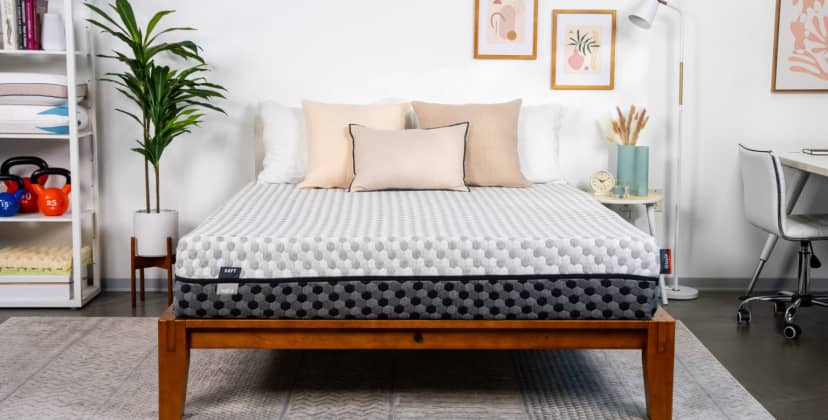
If you can’t settle on a firmness preference, why not try it both ways? The Layla Memory Foam is infused with copper gel for cooling and pressure relief and offers a medium-soft and a firm side in a flippable design that I’ve found surprisingly easy to manage, as it’s lighter than other reversible mattresses.
-
Pros
-
Flippable design offers 2-in-1 firmness
-
Copper-infused foams conform closely and should stay cooler than conventional foam
-
120-night sleep trial and lifetime warranty
-
-
Cons
-
People seeking a medium firm feel may not feel comfortable on either side
-
Deep sinkage likely when moving across both sides
-
Mattress Type
Foam
Firmness Options
Medium Soft (4), Firm (7)
Price Range
$749 – $1,249
Trial Period
120 nights (4 week minimum)
Who It’s Best For
The soft side appeals to those who sleep on their side and some back sleepers who weigh less than 230 pounds. The firm side works well for back and stomach sleepers over 230 pounds. Good for hot sleepers as well — the copper gel helps distribute body heat across the surface.
Feel
The softer side gives the sensation of a gentle hug, while the firmer side offers more support (potentially too much for lightweight sleepers). The gel-infused memory foam provides pressure relief for areas that need it.
What It’s Made Of
Both sides feature copper-infused memory foam for pressure relief and cooling, along with a high-density polyfoam support core. Its cover blends breathable materials with copper to combat heat retention.
What We Don’t Like
Those seeking a medium-firm feel are left wanting since one side is too soft and the other too hard. There have also been reports of deep sinkage on both sides of the bed.
Trial, Shipping, and Warranty
Layla guarantees their mattress with a 120-night sleep trial and a lifetime warranty. The bed ships free to the contiguous U.S.
The Lull Original feels like a textbook example of what a good memory foam mattress should be. The three-layer design creates just the right balance of cushioning and support, with a medium firm feel that worked well for both me and my partner.
-
Pros
-
Good for side sleepers and lightweight sleepers
-
Good motion isolation reduces night time disturbances for couples
-
Relatively inexpensive
-
-
Cons
-
May not provide enough support for heavier back and stomach sleepers
-
Foam layers tend to trap body heat throughout the night
-
Mattress Type
Foam
Firmness Options
Medium Firm (6)
Price Range
$755 – $1,699
Trial Period
365 Nights
Who It’s Best For
Since the Lull Original is medium firm, the mattress should hit the sweet spot for people who weigh between 130 and 230 pounds. Superior motion isolation makes the Original a solid choice for couples and co-sleepers, while the foam’s deep cushioning should also appeal to people with frequent or chronic back pain.
Feel
The Lull Original offers moderate contouring. You’ll feel the foam forming a cradle around your body’s unique curves, but the mattress shouldn’t hug you too closely. Dense transitional and base foam layers push back against your weight for added support.
What It’s Made Of
The Original’s top layer is composed of memory foam infused with cooling gel intended to reduce heat buildup. Transitional and support layers of dense foam help prevent sinkage to keep your body on an even plane. The cover is made of stretchy knit polyester.
What We Don’t Like
Back and stomach sleepers over 230 pounds will probably find the Lull Original a bit too soft. You’ll also notice some strong off-gassing smells for up to 72 hours after the mattress is unboxed — the odors eventually dissipate, but can make sleeping on the mattress unpleasant for the first few nights.
Trial, Shipping, and Warranty
The Lull Original is reasonably priced compared to the competition and ground shipping is free throughout the contiguous U.S. Your order comes with a generous sleep trial that runs for an entire year. If you decide to keep the mattress after the trial ends, your purchase is also covered under a lifetime warranty.
Video: We Tested 2025’s Best Memory Foam Mattresses — Here Are Our Favorites
What Is a Memory Foam Mattress?
A memory foam mattress includes at least one top layer of a special type of polyurethane foam (that’s the memory foam) that softens and molds to your body as you lie on it, then slowly bounces back when you get up. In fact, it got its name because it temporarily shows a “memory” of your body’s imprint, even after you’ve gotten up .
Most are made entirely of foam layers, with some featuring a base made of a higher density foam called polyfoam. Because of differences in manufacturing, not every memory foam mattress feels the same. Foam density and thickness, additional materials, and mattress firmness dramatically change how much comfort and support you feel.
In general, here’s what I’ve learned to expect from a memory foam mattress:
- Significant “hug,” contouring to your body’s shape and weight
- Minimal bounce
- Virtually no ripple effect from movement on one side of the mattress
- Quiet performance
- A greater tendency for heat buildup than other materials
Because of that last point, many modern mattresses include cooling features like gel infusions, copper, graphite, or breathable covers to help dissipate heat. But does cooling tech actually work? That depends on how it’s constructed. Our testing team evaluated how well gel memory foam works.
Who Should Buy a Memory Foam Mattress?
Let’s try a little exercise: Close your eyes and imagine you’re lying on the most comfortable mattress in the world. If you’re picturing yourself sinking into a mattress that softly cradles your body, you’ll more than likely enjoy sleeping on a memory foam mattress.
Still not sure if you should try one? From my own experience — plus insights from our medical advisors and testing team — I’ve found that there are a few types of sleepers who tend to be the best fit for a memory foam mattress.
Sleepers With Sensitive Joints
- Memory foam helps evenly distribute your weight across the mattress surface, taking some pressure off sensitive joints and areas prone to pain like the lower back.
- With the right firmness level, a memory foam mattress may improve comfort for people with medical conditions like arthritis, fibromyalgia, and sciatica.
Side Sleepers
- If you’re a side sleeper like me, memory foam provides cushion for your bottom shoulder and hip. It also helps you maintain a neutral spine, reducing the risk of morning aches and pains.
Couples
- Memory foam absorbs movement soundlessly, so I don’t feel (or hear!) my partner moving around on their side of the mattress.
Who Are Memory Foam Beds Less Than Ideal for?
While memory foam beds are great for many sleepers, they’re not for everyone. If you want a firmer mattress that doesn’t conform to your body, memory foam is decidedly not your jam. Hot sleepers, stomach sleepers, and people who want a bouncy mattress should also probably think twice before buying a memory foam mattress.
People Who Sleep Very Hot
- The downside of close-conforming memory foam is that it traps body heat. As a result, hot sleepers often feel too warm on a traditional memory foam mattress.
- Some newer memory foam mattresses have special cooling features, but you may still notice some heat retention.
Stomach Sleepers
- In our testing, we frequently find that stomach sleepers say memory foam is too soft and doesn’t have enough support for their midsection.
- If you’re a stomach sleeper who’s set on a memory foam mattress, look for one with a higher firmness level that can maintain a flat and even surface.
Sleepers Who Enjoy Bouncy Beds
- The material has almost no bounce to it, which can make it more of a chore to move around in bed.
People Who Prioritize Edge Support
- While I love memory foam, one of my biggest frustrations with it is that it can feel weak around the perimeter. On really plush memory foam, it can feel like I’m about to slide off when sitting on the edge.
What to Consider When Shopping For a Memory Foam Mattress
When I first started testing mattresses, I assumed every memory foam mattress would feel roughly the same. Turns out, I was in for a big surprise. In reality, memory foam mattresses come in a range of styles. Some really lean into the traditional feel of memory foam, while others change things up by pairing memory foam with latex or other types of foam.
That means you can find memory foam beds with different firmness levels and different degrees of hug, heat retention, and motion isolation. While that broadens your options, it’s also important to know what you’re looking for. Here are some of the things I’ve found to be most useful to consider when shopping for a quality memory foam mattress.
Sleep Position and Body Weight
When I shop for clothing, I can’t find the right fit unless I think about my body’s shape and size. The same applies to mattress shopping.
Optimal comfort and spinal support aren’t universal — they depend on your weight and how you position your body on a mattress. That’s a huge reason why mattresses, like most clothes, aren’t “one size fits all.”
If you sleep on your side, your bottom hip and shoulder push down into a mattress way more than they do in other sleep positions. Memory foam contours around these joints, making memory foam mattresses popular among side sleepers. However, if you’re a back or stomach sleeper, you typically need more firmness to keep your spine in an even plane and help prevent back pain.
Your weight influences how a mattress feels, too. A mattress that’s perfect for a heavier person may feel too firm to someone of a lighter weight. Similarly, a mattress that feels comfortable and supportive to a lighter person may feel too soft for a heavier individual.
And though comfort is ultimately subjective, our testing team put together some general recommendations for mattress firmness based on your sleeping position and body type. We rate firmness on a scale of 1 to 10, with 10 being the firmest.
| Weight | Side Sleepers | Back Sleepers | Stomach Sleepers |
|---|---|---|---|
| Less than 130 lbs. | Soft (3) to Medium Soft (4) | Medium Soft (4) to Medium (5) | Medium (5) to Medium Firm (6) |
| 130 to 230 lbs. | Medium (5) to Medium Firm (6) | Medium Firm (6) to Firm (7 or 8) | Medium Firm (6) to Firm (7 or 8) |
| More than 230 lbs. | Medium Firm (6) to Firm (7 or 8) | Firm (7 or 8) to Extra Firm (9) | Firm (7 or 8) to Extra Firm (9) |
Contouring and Pressure Relief
All memory foam mattresses will contour to your body to some degree. But I’ve found that there’s a lot of variation in just how much of a hug you’ll get.
Ultimately, the right amount of hug depends on your sleep style and preferences. If you have sharp pressure points — say, if you’re a side sleeper with broad shoulders — you may want deeper contouring so that your shoulders get plenty of cushioning.
But if you’re a back or stomach sleeper, that level of hug may be overkill. In fact, it may even cause your midsection to sink down into the mattress, setting you up for an achy lower back in the morning.
Motion Isolation and Noise
Sharing a mattress isn’t always conducive to high-quality sleep, especially if your bed partner is constantly tossing and turning. Thankfully, a quality memory foam mattress can dramatically reduce disruptions from movement on the other side of the bed. It also stays quiet — no squeaky springs here!
However, through testing, I’ve observed that some memory foam mattresses are far better at limiting noise and motion transfer. I recommend that couples who share a bed look closely at test results (we break down each mattress’s scores on their individual review pages) and customer ratings to gauge just how well a specific model performs in these areas.
Temperature Regulation
Hot sleepers should proceed with caution when buying a memory foam mattress. That doesn’t mean they should avoid these mattresses altogether, but being aware of temperature regulation can help zero in on the ideal mattress.
Traditional memory foam was known for major heat buildup. Thankfully, most mattresses today have design features meant to resist overheating. For example, you may see options with cooling gels, copper, or other materials that have been infused into the foam layers. Breathable covers with specialty fabrics are also getting more popular as a way to try to limit heat retention.
In my experience, these features can be kind of hit or miss. Certain mattresses do a good job of staying cool, and others feel really hot. Again, testing data and customer reviews are your best friend here.
Edge Support and Ease of Movement
Some people dislike the feel of memory foam because it can be weaker around the edges and may leave sleepers feeling “stuck” in the mattress. I only notice these issues on really soft memory foam mattresses, so this is far from a dealbreaker for me. But if top-notch edge support and ease of movement are important to you, it makes sense to look for a firmer memory foam mattress (or even consider another type of mattress, like a latex or hybrid model).
Off-Gassing
Unboxing a new memory foam mattress can be exciting, but you might also notice a chemical smell — that’s off-gassing. This odor comes from volatile organic compounds (VOCs) released by the foam during manufacturing. While the scent is usually harmless and fades within a few days, it can be bothersome if you’re sensitive to smells or have respiratory issues.
I recommend unboxing the mattress in a well-ventilated space and giving it time to air out before you sleep on it. If you want to avoid strong odors altogether, look for CertiPUR-US certified foams, which meet standards for low emissions.
Budget
As with any purchase, price is an important factor. I used to think that a more expensive mattress was always better, but I’ve tested enough mattresses to know that price doesn’t necessarily always reflect quality.
A great mattress is a worthy investment, so I don’t recommend shopping based on price alone. Instead, give yourself a general price range (lowest, ideal, and absolute max) and use that to narrow down your options. From there, you can pick the mattress that best suits your sleeping position, body weight, and comfort preferences. You can also check out our guide to the best affordable memory foam mattresses.
Sleep Trials
I’ve experienced firsthand how much you can learn about a mattress by sleeping on it for a few weeks. That’s why I always recommend buying a mattress with an extended sleep trial.
In the mattress industry, a “sleep trial” is a marketing term for a flexible return policy. Most online companies give you a few months to test out a mattress at home with the option to return it for a full refund. The standard sleep trial is around 100 nights, but some last for a full year.
Before making a purchase, take a few minutes to read the details of the sleep trial (and the other fine print, while you’re at it), so you know your options if you later find that the mattress isn’t working for you. For example, some companies make you “break in” the mattress for at least a month before you can return it, and others charge return fees.
What Does a Memory Foam Mattress Feel Like?
Ever make a snow angel in soft, powdery snow? If so, you’ve got a preview of what a memory foam mattress can feel like (minus the frigid temperatures). As you lie down, the material cradles your body with a soft hug. And like a snow angel, you can see your body’s imprint when you get up from a memory foam bed before it retakes its original shape.
Personally, I love that memory foam is so inviting and accommodating. As I get settled in for bed, it helps me relax, as I feel my mattress adapt to and softly cradle my body. It lets me sleep without pressure building up in my shoulders, hips, or lower back.
But just as not everyone likes hugs or making snow angels, memory foam isn’t right for every sleeper. Some people find that it contours too closely to their body, and a few people even go so far as to say it feels suffocating. As with every mattress, comfort is subjective, so find what feels best for you.
What I’m Sleeping On
When my wife and I are in between mattress testing sessions, our go-to is the WinkBed — specifically, their softest model. We’ve been sleeping on it for three years now, and it still feels incredibly comfortable and supportive. Even though it’s technically a hybrid mattress, there’s plenty of cushiony memory foam: a 2-inch layer of temperature-neutral foam and a support layer of CertiPUR-US Certified foam.
One thing I especially appreciate is how the Euro pillow-top and memory foam layers work together to cushion my hips and shoulders without sacrificing spinal alignment. You get that plush, contouring feel from the memory foam right but without the “stuck” sensation that sometimes comes with all-foam beds. It’s been a game-changer for both of us, and honestly, the quality you get at this price point is hard to beat.
How We Test: Your Comfort Is Our Science
When it comes to mattress testing, we get serious. In our Seattle-based Test Lab, we use an objective, hands-on process to evaluate mattresses, and we’ve used that process to test over 2,000 mattresses in the last decade.
Our industry-leading product testing team cares deeply about improving your sleep. Since a bed’s comfort and feel depend largely on body weight and sleeping position, our team represents a wide range of body types, sleep positions, and comfort preferences.
During our testing, we draw on multiple sources of information that each enhance our overall perspective.
Construction analysis: Our ratings system is grounded in mattress design and construction. We look at how each layer of a mattress contributes to its overall feel and performance, and we account for special features like cooling technology.
Quantitative product testing: During in-lab testing, our team uses multiple tools and technologies to measure a bed’s performance in categories like motion isolation, pressure relief, and temperature regulation. We use the outcomes from these tests to calculate a score for each category.
Field testing: Our field testers (such as yours truly) sleep on mattresses in their own bedrooms. After weeks of at-home testing, each field tester provides a detailed analysis of how the mattress performed in a real-world setting.
User feedback: Beyond our team, we draw insight from surveys and verified customer reviews to identify problem areas, fine-tune our ratings, and better understand how each product performs over time.
How We Determine Our Overall Scores

When you look at our mattress reviews, you’ll see ratings for six key categories. Not every performance category is equally important to your overall satisfaction with a mattress, so we give some categories greater weight when determining an overall score. Here’s a quick breakdown of the categories and why they’re important.
Performance Categories
Motion Isolation
This is how much vibration a mattress absorbs when someone moves on its surface. We measure this with a vibrometer, and the results help determine whether you’ll be woken up when your bed partner rolls over or gets in or out of bed.
Temperature Control
No one wants to wake up clammy and hot, so we perform temperature tests with a heat gun to see how much a mattress heats up and how quickly it dissipates any built-up heat.
Pressure Relief
In this guide, I’ve already covered why memory foam is so great at pressure relief. We use pressure mapping technology that shows just how much impact occurs around the heavier parts of the body.
Edge Support
Mattresses with strong edge support provide a more dependable and reliable sleep surface. We perform tests measuring how much the edges sink when you sit or lie down near the perimeter and how long it takes for the edge to return to its original shape.
Ease of Movement
This category reflects how easy it is to move on the bed’s surface. Materials like latex tend to get higher scores for ease of movement. As with testing edge support, we use kettlebells to determine how deeply a mattress compresses and how quickly it bounces back.
Off-Gassing
A mattress that has been compressed to ship in a box can release unpleasant chemical odors due to volatile organic compounds (VOCs). Though they’re not harmful, they can be annoying, so we analyze how strong the smell is and how long it takes to fade away.
More Mattress Guides
Our team tests mattresses to determine the best options for different types of sleepers. To see how we’ve ranked mattresses in other performance categories, check out the product guides below.
Shopping Guides by Mattress Type
- Best Mattress for Sciatica
- Best Mattress for Scoliosis
- Best Mattress for Athletes
- Best Affordable Memory Foam Mattress
- Best Tempur-Pedic Mattress for Side Sleepers
- Best Tempur-Pedic Mattress for Back Sleepers
- Best Tempur-Pedic Mattress for Stomach Sleepers
- Best Mattress for Seniors
- Best Mattress on Amazon
- Best Mattress for Couples
- Best Gel Mattress
Frequently Asked Questions
How long do memory foam mattresses last?
Our analysis shows that, on average, a memory foam mattress is good for six to seven years of continuous nightly use. Around that point, the foam may begin to soften, which can reduce its comfort and supportiveness.
But that’s not always the case, and some mattresses can last longer. Ensure you get the longest lifespan out of your mattress by preventing damage from, for example, jumping children or sharp pet claws.
Can you put a memory foam mattress on a box spring?
We’ve tested all kinds of arrangements, and we’ve found that a box spring isn’t ideal for a memory foam mattress. Box springs have built-in coils with gaps between them, and those gaps create zones of reduced support for a memory foam mattress.
Memory foam mattresses tend to work best on a solid foundation, such as a platform bed. And using an appropriate bed base is often required to maintain the validity of your mattress warranty. For that reason, I suggest checking with the company that makes your mattress for specific recommendations about the type of foundation to use.
What memory foam mattresses are good for sleepers with back pain?
Except in rare cases, you shouldn’t flip a memory foam mattress. Typically, memory foam layers are near the top of the mattress where they can deliver more comfort and cushioning. If you flip the mattress over, those layers will be near the bottom, dramatically reducing the support they can give you.
That said, you can rotate a memory foam mattress, as long as the top cover should always be facing up. And some mattresses are designed to be flippable, using memory foam on both sides. These mattresses usually have a different firmness level on each side, so you can flip them to whichever side feels more comfortable.

Still have questions? Ask our community!
Join our Sleep Care Community — a trusted hub of product specialists, sleep health professionals, and people just like you. Whether you’re searching for the perfect mattress or need expert sleep advice, we’ve got you covered. Get personalized guidance from the experts who know sleep best.
References
1 Sources
-
Forty-Year-Old Foam Springs Back With New Benefits | NASA Spinoff. spinoff.nasa.gov/Spinoff2005/ch_6.html.
https://spinoff.nasa.gov/Spinoff2005/ch_6.html


